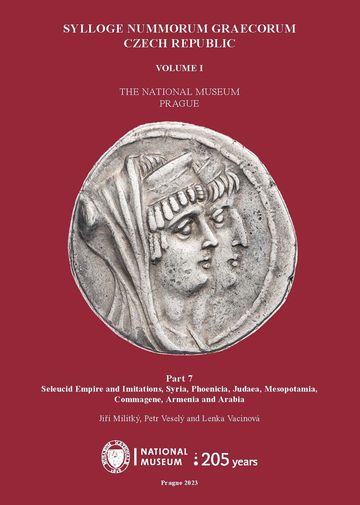
Sylloge Nummorum Graecorum Czech Republic. Volume I. The National Museum. Prague. Part 7. Seleucid Empire and Imitations, Syria, Phoenicia, Judaea, Mesopotamia, Commagene, Armenia and Arabia
ISBN: 978-80-7036-783-4, 978-80-7036-784-1 (pdf)
Author(s): Jiří Militký, Petr Veselý and Lenka Vacinová (with contribution by Marek Fikrle)
Publisher: National Museum
Type of publication: Book / E-book
Place of publication: Prague
Number of pages: 287
Citation: MILITKÝ, Jiří, VACINOVÁ, Lenka and VESELÝ, Petr. Sylloge Nummorum Graecorum Czech Republic. Volume I. The National Museum. Prague. Part 7. Seleucid Empire and Imitations, Syria, Phoenicia, Judaea, Mesopotamia, Commagene, Armenia and Arabia. First edition. Prague: National Museum, 2023. 287 pages. ISBN 978-80-7036-783-4, 978-80-7036-784-1 (pdf).
The catalogue, arranged according to standard rules geographically and chronologically and based on the metal and denominations, contains 725 coins illustrated on 91 BW and 52 colour plates. In the introductory text, the history of the relevant part of the numismatic collection is presented including its beginnings, the origin of individual acquisitions and previous fate of particular private collections which came to the National Museum.
Coins of the Seleucid Empire and Syrian cities are the most numerous components in the published assemblage. Thus, a fairly representative overview of Seleucid coinage was made covering the time span from Seleucus I to Antiochus XIII. The catalogue also includes several previously unpublished coins, and numerous variants of previously unpublished variants demonstrating the extraordinary variety and intensity of Seleucid coin production. The second most numerous assemblage within the published volume represent the coins of ancient Judaea from the Hasmonaeans to the Second Jewish Revolt, including the Roman Provincial issues.
The coinage of ancient Phoenicia is considerably less numerous and represented mostly by the production of Aradus. The rest of the relevant territories, i.e. Mesopotamian, Armenian and Arabian issues, are presented only marginally within the published numismatic material.
An important part of the publication are the results of the XRF analyses of particular coins, and their evaluation. The published numismatic material and the way of its presentation is intended to make it available to further scientific research and to develop the current knowledge on the coinage of the Middle Eastern part of the ancient world.
The e-book can be purchased in the online store Palmknihy.
